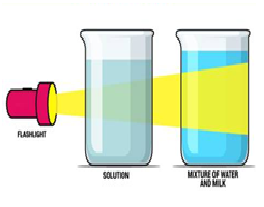

Sodium Sulphate forms ……. at 32.4OC.
a) anhydrous
b) deca-hydrate
c) both a & b
d) all of these
Explanation:A hydrate whose solid contains ten molecules of water of crystallization per molecule, or per unit cell called deca-hydrate.
Sodium Sulphate forms ……. at above than 32.4OC.
a) anhydrous
b) deca-hydrate
c) both a & b
d) all of these
Explanation:A substance is anhydrous if it contains no water. Many processes in chemistry can be impeded by the presence of water; therefore, it is important that water-free reagents and techniques are used.
The maximum solubility of sodium sulphate is at ……..
a) less than 32.4OC
b) 32.4OC
c) above than 32.4OC
d) 52.5OC
Comparison of solution, Suspension and Colloids:
Scattering of light by colloidal particles is called ……….
a) Tyndall effect
b) Stark effect
c) Zeeman effect
d) Batman effect

….………can be used to distinguish between solution & colloid.
a) Zeeman effect
b) Tyndall effect
c) Stark effect
d) Batman effect